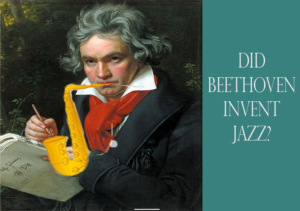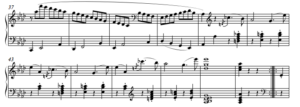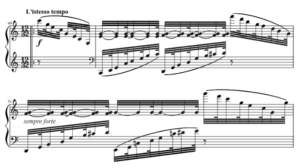 Did Beethoven invent jazz?
Did Beethoven invent jazz?
No, of course not! (But hey, can’t I have a little fun with a blog title once in a while?)
But what Beethoven did do, was to use a few musical elements that would become cornerstones of the jazz style, 110 years later.
Curiously, Beethoven used one of these jazzy elements in the 1st movement of his first piano sonata and the other in the last movement of his last piano sonata; effectively bookending his 32 piano sonata output with elements of jazz.
Even at his most playful, Beethoven isn’t really a “jazzy” composer in the sense that Bach and Mozart can be. There are many places in both of those composer’s works that are very close to jazz in spirit and sound. So it’s all the more striking to find these two passages in Beethoven where he foreshadows jazz so exactly.
Beethoven spent his whole career breaking down musical barriers into abstraction. (Unlike Bach, who was born into a fully-developed contrapuntal tradition and was already abstract from the beginning.) Beethoven took the music of the early classicists and gradually made things “less obvious.” What key are we in? Where’s the downbeat? What’s the musical form? (Yes, other composers did this sometimes too, but Beethoven took this principle very, very far. So far, in fact, that he led us right out of the Classical and into the Romantic period of music!)
Even in his very first piano sonata, which he composed when he was only 14 years old(!), Beethoven did what he could to disguise the downbeat. The first beat of each measure is traditionally emphasized, but in one passage, Beethoven has the pianist’s left hand only playing chords on beats 2 and 4. (Sound familiar, jazzers?) Of course these are the very beats that jazz musicians tend to emphasize. It’s one of the specific characteristics of jazz and can be heard everywhere from a drummer’s high hat rhythm to the accents in a walking bass line.
Here’s Beethoven’s score. Check out the LH chords on beats 2 and 4:

If we fast-forward to the early jazz era, we find this technique used by groups such as Louis Armstrong’s Hot Five. At times, the band would accompany the soloist with this exact rhythm. Everyone, even the drummer, would leave beats 1 and 3 empty while the soloist soared above this unusual pattern. The effect is the same as with Beethoven’s sonata: a syncopated rhythm with a lively sense of forward propulsion.
When Beethoven again anticipated jazz, in his final piano sonata, the effect is even more striking. The last movement of Piano Sonata No. 32 is written in a fast triplet rhythm that sounds like it “swings” in the jazz sense. He even has the right hand play a “Charleston” rhythm with chords on the downbeat and the “and” of beat 2. Here’s the excerpt:

I made a video so you can hear these 2 examples:
Did Beethoven invent jazz?
So even though Beethoven didn’t exactly invent jazz, it’s fascinating to see how his musical interests led him to use some of the exact rhythmic techniques that early jazz musicians like Jelly Roll Morton and Louis Armstrong used a century later. Even though they each came from a different time and culture, they were looking for at some of the same things in their music.
And by the way, Beethoven used jazzy “blue” notes in each of these passages. Jazzy rhythms plus blue notes. Coincidence? 🙂
Get my free ebook: Left Hand Techniques for Jazz Piano
You’ll also get my weekly jazz newsletter with practice tips and inspiration


[…] very first piano sonata as was discussed in an article written for keyboard improv cheekily titled Did Beethoven Invent Jazz? In this piece, pianist Ron Drotos breaks down a portion of the sonata in which one section has […]
Beethoven created ragtime, along with other romantic composers; Chopin being another popular example. Whether or not being PC (Politically correct). Ragtime was not suddenly founded years later in the century, that is BS. Ragtime has elements taken from classical music. I would not doubt if it were inspired by the compositions, but to claim that this style of music was “new” at the time would be silly. “But what Beethoven did do, was to use a few musical elements that would become cornerstones of the jazz style, 110 years later.” So in other words he created a foundation of a new structure style of music that other people based their compositions from…. gee! Poor Beethoven cannot get credit for creating a new musical genre. Thank you Beethoven, because without you, the Romantic era would have been so much different for music.
“And by the way, Beethoven used jazzy “blue” notes in each of these passages. Jazzy rhythms plus blue notes. Coincidence? ?” Because he helped form the foundation of the genre that many people are afraid to admit his influence in. Beethoven used “notes” and he used scale degrees among other composing techniques.
Not only did he start the romantic era, but I believe his opus 106 is the very first modern composition. elements of set theory and and modulations in thirds that do not share the key etc. etc.
there is even rotational voicing and little occurences of bitonality in the 4th movement.
the man was a genius pure and simple.
Only a fool would think that Charlie Parker is just a Xerox of Beethoven ..
Exactly! Who says that?
Yes, truly amazing!
The YouTube link returns “this video is unavailable”. Any chance this could be uploaded again soon? Thanks!
Hi Hassan, Thanks for reading! On the video, I just played the beginning of Beethoven’s Piano Sonata in Fm, demonstrating how he placed the LH chords on beats 2 and 4, like jazz musicians later did at times. It was very tongue-in-cheek, since obviously Beethoven didn’t invent jazz, and I pointed that out as well. But some people took it seriously and argued pro and con, so I took it off to avoid all that. Good luck with your music!
Hi Ron,
My field is actually philosophy of art, with a special focus on music. From my perspective, it’s not a pro or con thing, but more about the fact that what you wrote stirred the dialogue and encouraged the clarification of concepts. So, I’m already grateful for that.
Food for thought: the philosopher Isaiah Berlin divided thinkers between “foxes and hedgehogs” (also tongue-in-cheek!). Very succinctly: thinkers with one big idea and thinkers who relate to a plurality of ideas. I think Beethoven is a “fox”, since he didn’t limit himself to one musical paradigm. I think that even time didn’t have much of a grip on him, and that’s maybe why we sometimes hear traces of other centuries in his music, without necessarily having to see in that a causal relationship.
Thanks again!
I agree that the dialogue and exploring ideas is what is most important here. As for the topic at hand, it’s not that Beethoven wrote or played jazz, it’s that jazz drew on various musical and cultural elements, including the type of syncopation that was sometimes used by classical composers. Jelly Roll Morton was very familiar with the classics.